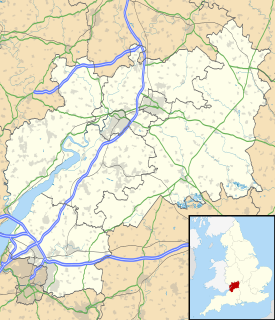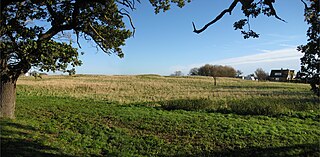Related Research Articles

Gloucestershire is a county in South West England. The county comprises part of the Cotswold Hills, part of the flat fertile valley of the River Severn, and the entire Forest of Dean.

Sudeley Castle is located in the Cotswolds near Winchcombe, Gloucestershire, England. The present structure was built in the 15th century and may have been on the site of a 12th-century castle. The castle has a notable garden, which is designed and maintained to a very high standard. The chapel, St. Mary's Sudeley, is the burial place of Queen Catherine Parr (1512–1548), the sixth wife of King Henry VIII, and contains her marble tomb. Unusually for a castle chapel, St Mary's of Sudeley is part of the local parish of the Church of England. Sudeley is also one of the few castles left in England that is still a residence. As a result, the castle is only open to visitors on specific dates, and private family quarters are closed to the public. It is a Grade I listed building, and recognised as an internationally important structure.

Winchcombe is a Cotswold town in the local authority district of Tewkesbury, Gloucestershire, England. Its population according to the 2011 census was 4,538.

Berkeley Castle is a castle in the town of Berkeley, Gloucestershire, UK. The castle's origins date back to the 11th century, and it has been designated by English Heritage as a grade I listed building.

The Gloucestershire Warwickshire Steam Railway is a volunteer-run heritage railway which runs along the Gloucestershire/Worcestershire border of the Cotswolds, England.
Winchcombe Abbey is a now-vanished Benedictine abbey in Winchcombe, Gloucestershire, this abbey was once in the capital of Mercia, an Anglo Saxon kingdom at the time of the Heptarchy in England. The Abbey was founded c. 798 for three hundred Benedictine monks, by King Offa of Mercia or King Kenulf. In its time, it was the burial place of two members of the Mercian ruling class, the aforementioned Kenulf and his son Cynehelm, later venerated as St. Kenelm.

Gloucester Castle was a Norman-era royal castle situated in the city of Gloucester in Gloucestershire, England. It was demolished in 1787 and replaced by Gloucester Prison.
Winchcombe was, from 1894 to 1935, a rural district in the Cotswolds area of England. It included parts of two administrative counties: Gloucestershire and Worcestershire.
Lampeter Castle, sometimes known as Stephen's Castle, was built during the Norman expansion into Wales at the end of the eleventh century. The motte is in the grounds of Lampeter University but the precise whereabouts of the bailey is unknown. It was captured by Cadell ap Gruffydd in 1146.

Adulterine castles were fortifications built in England during the 12th century without royal approval, particularly during the civil war of the Anarchy between 1139 and 1154.
Winchcombe Nunnery was a nunnery in Gloucestershire, England.

Woodwalton Castle was a small motte and bailey castle at Church End, the northern end of the parish of Woodwalton, Huntingdonshire. Located on a natural hillock, the earthworks of the castle still remain, with an outer moat enclosing a circular bailey with a central motte. A large dyke, apparently ancient, runs from the outer moat in a north-easterly direction. The site is a scheduled ancient monument.
Bledisloe Tump was a castle in the village of Awre in Gloucestershire, England.

Castle Tump was a castle in the village of Dymock in Gloucestershire, England.

Hailes Castle was a castle in the village of Stanway, Gloucestershire in Gloucestershire, England.
Stow Green Castle, also known as Castle Tump, was a castle near the village of St Briavels in Gloucestershire, England.
Littledean Camp was originally a castle overlooking the village of Littledean in Gloucestershire, England, notable for its unique early Norman design.
South Cerney Castle was an adulterine castle of Motte and bailey construction built in South Cerney, Gloucestershire in the mid-12th century. Today only slight earthwork remains and they are a scheduled monument.

Spoonley Wood Roman Villa is an ancient Roman villa located 2 km south-east of Sudeley Castle near the town of Winchcombe, in Gloucestershire, England. It was a courtyard-type villa excavated in 1882. Some remains of the villa, partly reconstructed, can still be seen in Spoonley Wood, and one mosaic is viewable under a corrugated iron roof.
References
- 1 2 3 Walker, p.15.
- ↑ Walker, p.15; National Monuments Record website, accessed 20 December 2010.